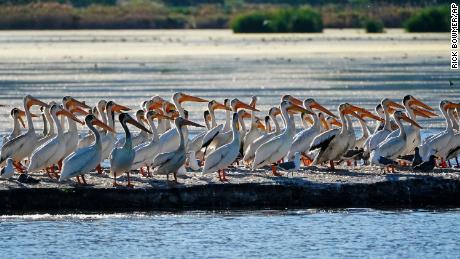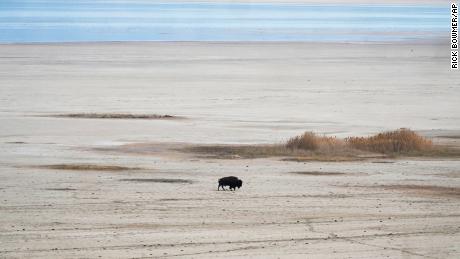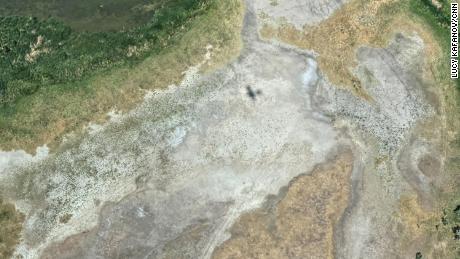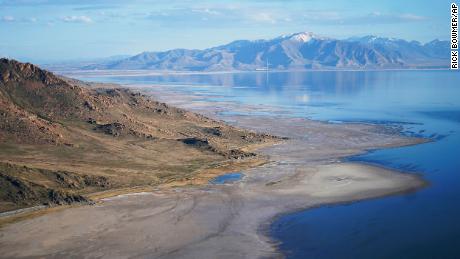Great Salt Lake is shrinking fast. Scientists demand action before it becomes a toxic dustbin.
“I have never seen it this bad — not in my lifetime,” said Andy Wallace, soaring over the body of water in a prop plane, as he’s done for years as a commercial pilot.
Simply put, the largest salt lake in the Western Hemisphere is shrinking rapidly. Left alone, the lake’s footprint would span 2,100 square miles — more than three times the area of Houston. An analysis published last year showed that water siphoned off the rivers that feed the natural wonder had reduced its level by 11 feet, depleting the lake area by more than half.
“Twenty years ago, this was under about 10 feet of water,” said Kevin Perry, chairman of the department of atmospheric sciences at the University of Utah, as he rode a bike in July across the desiccated lake bed.
Dying organisms and arsenic
Perry and other scientists worry they’re watching a slow-motion calamity unfold. Ten million birds flock to the Great Salt Lake each year to feed off of its now-struggling sea life. More pelicans breed here than most anywhere else in the country.
“We think of these structures as living rocks,” said Michael Vanden Berg, manager of the survey’s energy and mineral program. “The population in Great Salt Lake is one of the largest accumulations of modern microbialites in the world.”
If the lake continues to recede to historic levels, a heretofore unseen proportion of the lake’s microbialites will be exposed, a news release said. It can take only weeks for the microbial mat to erode off the “living rocks,” it said, and it could take years to recover, even if lake levels return to normal.
Brine shrimp, also known as sea monkeys, are also battling the rising salinity that comes with less water. They’re not just bird food, either. They’re exported as fish food, and commercial harvesting contributes to an estimated $1.5 billion economy — which, along with recreation and mineral extraction, helps feed fishers and others living around Great Salt Lake.
Economic downturn isn’t the only threat to humans in the area. Utah’s soil is naturally high in arsenic, a toxic compound that causes a frightening range of health problems. When it washes downstream, it lands in the lake, Perry said. When the wind blows, as it regularly does quite fiercely, it kicks up the dusty lake bed.
“One of the concerns we have is the particles that are coming off the lake getting into people’s lungs,” he said. “Fifteen to 20 years ago, when the lake was higher, most of these dust spots were covered up, and if you cover them up with water, they don’t produce dust. And so as the lake has receded, it’s exposed more and more of that lake bed. … As we get the larger area, we have more frequent dust storms.”
“This lake could become one of the larger dust emission sources in North America as well,” he said. “Right now, the lake bed is protected by a fragile crust, and if that crust is disturbed or erodes over time, then this lake could start to emit a lot more (dust).”
‘We’re on the doorstep of a catastrophe’
Huge swaths of the Utah lake look more like Death Valley than any waterway, the ground barren and fractured from dry heat. Other areas look like sprawling street puddles. Birds wade through shoreline muck along empty marinas, their slips sagging to the ground.
The shallow waters are more prone to evaporation in drought conditions, and while the lake’s level ebbs and flows over any given year, the lake tends to reach its low point in the fall, around October. The lake will continue to drop and shrink over the next three months, and the water level could sink as much as 2 more feet by Halloween, Butler suspects.
“Keeping water in Great Salt Lake is the biggest thing that keeps me up at night,” said Butler, a wildlife biologist who grew up around the lake and serves as coordinator for the Great Salt Lake Institute at Westminster College. “We’re on the doorstep of a catastrophe.”
Mother Nature and residents must join forces
Butler wept contemplating the ramifications of not taking strong action to save the waterway.
“Great Salt Lake will be an environmental, economic and, really, cultural catastrophe all in one,” she said. “I grew up here. A place becomes you. … We are all Great Salt Lake. All of us are, and we shouldn’t let it go away.”
Humans created the problem, and humans will have to take part in the solution, she said. Curbing water usage and raising water utility rates to deter waste would be a start, she added.
Despite the warning bells, water meant for Great Salt Lake continues to be diverted to farms, ranches and cities — the latter of which enjoy some of the cheapest water in the nation, Butler said.
But it seems residents around Great Salt Lake have been acting more conscientiously, said Marcie McCartney, the water conservation and education manager for the Utah Division of Water Resources.
“Everybody around and in that basin is doing all they can to use water as wisely as possible,” she said. “We’re seeing a lot of (water) saving this year, which is awesome, but the Great Salt Lake is definitely suffering, and the only way we’re going to get those lake levels up higher is a better water year for our snow pack.”
Officials charged with monitoring the snow runoff into streams and reservoirs must calculate how much is needed for water supply — drinking, agriculture, etc. — and the rest can be released downstream into Great Salt Lake, McCartney explained. This year’s “poor snow pack” melted too quickly, she said, “and the soil is really thirsty.”
“Mother Nature is going to take her share first, and we’ll get the rest,” she said.
“Great Salt Lake experienced her final glimmering sunset today, succumbing to a long struggle with chronic diversions exacerbated by climate change,” it began. “Her dusty remains will be scattered across the Salt Lake Valley for millennia — we will be constantly reminded of her passing by our air quality monitors.”
The piece laid out the history of the reservoir, how it found itself in dire straits and what concerned Utahans can do to change the narrative and amplify their voices to save the beloved body of water.
“There was action to prevent the death of Great Salt Lake, but it was too little, too late,” the obit read. “She supported Utah’s economy for many years, but we did not adequately fund her healthcare in time. Had we done so, we may not be mourning her death today.”
Speaking to CNN, Butler reiterated many of those points, imploring, “We’ve changed our world, and we need to change our behaviors to keep incredible ecosystems that include humans like here at Great Salt Lake.”
![]()













